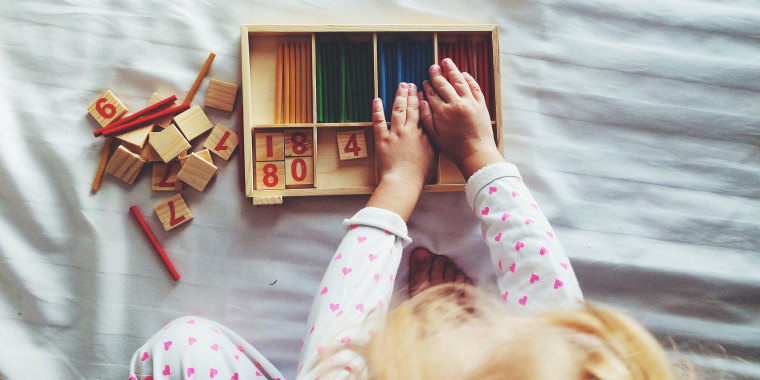Want to help your kindergartner master math? Here are some of the skills your child would be learning in the kindergarten classroom.
Numbers
Words and numerals for numbers
Know the words for numbers (“one,” “two,” “three,” “four” for 1, 2, 3, 4) through 20. Write numbers from 0 through 20.
Counting to 100
Count to 100, by ones and by tens.
Tip: Incorporate basic math concepts.
Try to incorporate basic math concepts into everyday activities. Have your child count objects regularly and pose easy counting challenges, such as counting the number of steps on a flight of stairs or the number of red cars you see while driving. Take opportunities to count by twos or fives or tens, for example if you’ve bought many of the same item at the grocery store or need to count a pile of coins.
Counting objects in groups
Count how many objects are in a group (to 20). By counting or matching objects, tell whether the number of objects in one group is greater than (more) or less than (less), or equal to (the same as) the number of objects in another group.
Comparisons between small numbers
Compare any two numbers between 1 and 10, and tell which is greater than or less than the other.
Understanding numbers 11 - 19
Understand numbers 11 through 19 as ten ones and some additional ones.
Addition, subtraction, multiplication, & division
Addition & subtraction
Understand addition as “putting together” and “adding to.” Understand subtraction as “taking apart” and “taking away from.”
Tip: Apply math to everyday life.
It's especially memorable to children when they can use their new math concepts in their everyday life. Have your child arrange their favorite stuffed animals in a circle for a party and give two or three crackers to each toy. Have them add up the total number of crackers distributed. Ask them to predict how many more crackers they would need if one of their toy action figures joined the party. Then ask them to predict the total number of crackers needed with yet another guest. This gives them an opportunity to "add up" in their head and then see if they are correct when they actually add the next figure and counts up the new total. The game can be played in reverse when one of the figures leaves the party, taking their crackers with them.
Master adding and subtracting
Add and subtract within 5 (1 to 5) quickly and accurately.
Solving word problems
Using objects, fingers, simple math drawings, or mental images, solve addition word problems involving numbers that add up to 10 or less, and subtraction word problems involving subtraction from 10 or less.
Adding to 10
For any number, 1 through 9, find the unknown number (quantity) needed to total 10. Show the answer with a drawing or equation (number sentence).
Breaking up numbers
Break up numbers, 3 through 10, into pairs, in more than one way.
Measurement & data
Measuring in different ways
Understand that objects can be measured in different ways: length (“how long”), height (“how high” or “how tall”), and weight (“how heavy”). Compare the length, height, and/or weight of two objects.
Relative position of objects
Describe the relative position of objects – for example, above, below, in front, behind.
Shapes
Naming common shapes
Name common shapes, such as squares, rectangles, circles, triangles. Describe common shapes in simple terms: “Circles are round.” “Triangles have three sides.”
Tip: Practice shape recognition.
Practice recognition of different shapes. Have your child spot things that are triangular, like pieces of pizza or the roof of a house, or rectangular, like paper money. As you talk about different shapes, have them describe why a shape they spot is a triangle (three sides) or a square (four equal sides) or a rectangle (two opposite equal sides and two other opposite equal sides of longer length).
Understanding flat and solid shapes
Understand the difference between “flat” or two-dimensional shapes (a square or circle drawn on paper) and “solid” or three-dimensional shapes (a wooden block or cube; a sphere or globe).
Creating shapes
Use building and drawing to create shapes.
For tips to help your kindergarten in math class, check out our kindergarten math tips page.
TODAY's Parenting Guides were developed by NBC News Learn with the help of subject-matter experts, and align with the Common Core State Standards.


